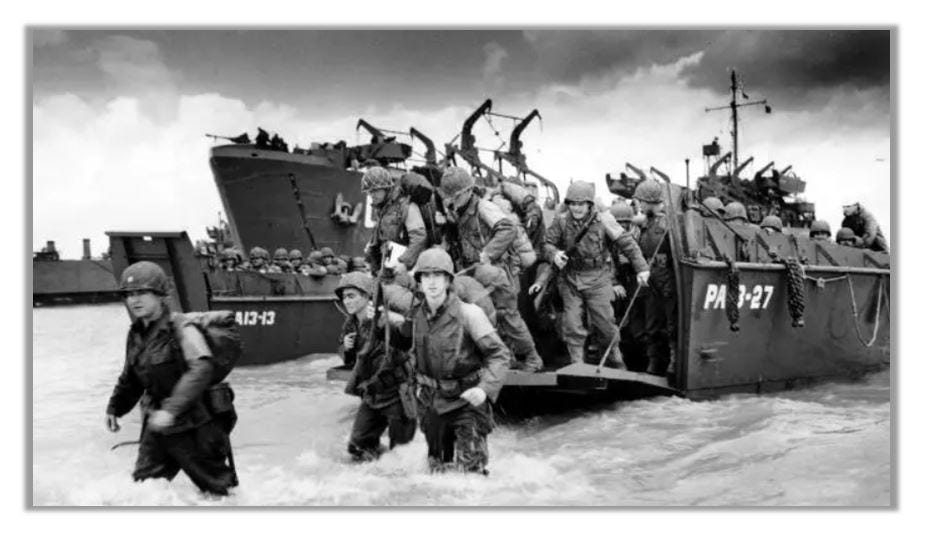At about this time in 1944, American forces engage in training exercises for the D-Day invasion of Normandy. Exercise Tiger was intended to simulate every aspect of the landings at Utah Beach. Unfortunately, it ended in tragedy and disaster instead.
Exercise Tiger was basically a dress rehearsal for D-Day. Everything was supposed to be as real as possible. An English beach similar to the actual target in France was used—as was live ammunition.
Americans ships would travel long, meandering courses in a bay to mimic a crossing of the English Channel. A British cruiser would bombard the beach early on April 27, shortly before American forces made their landings. A second convoy would deliver more troops early on April 28.
The bombardment and landings on April 27 didn’t go well. Poor communication led to many unnecessary friendly fire casualties.
Yet the next night was even worse.
A convoy of 8 Landing Ship Tanks was in the area, as it was responsible for the early morning landings on April 28. That convoy was guarded by only one British vessel, HMS Azalea. Unfortunately, a group of German E-boats was also nearby. It zeroed in on the convoy, then launched torpedoes in a hit-and-run attack. Two LSTs would sink. One was badly crippled. The remaining LSTs were ordered into retreat. The crews left behind were in dire straits. The soldiers, especially, were in trouble. They hadn’t been trained in water tragedies, as the sailors had.
“The Army men they had aboard,” one Navy petty officer described, “knew little about disasters at sea. . . . it was obvious to us that they were wearing [their lifebelts] wrongly—around their waists, instead of up under their armpits. But it was too late to tell them . . . .”
Lifeboats were another problem. Some were damaged by torpedoes, but others were literally stuck to the ships. “[The restraining pins] were rusted solid and would not unhinge,” one survivor later described. He took a gun and fired shots at some restraining cables, finally freeing a lifeboat.
The water was freezing, but then extreme heat turned out to be a problem, too: Fuel was burning!
“I felt a sharp burst of heat strike the back of my neck,” Navy Corpsman Arthur Victor wrote. “Then someone started screaming hysterically that the water was on fire. I turned quickly and stared at flames and billowing black smoke . . . . [B]y some miracle, the fire suddenly died out not more than 20 feet away.”
He credited God with saving him.
Men died of hypothermia as they waited for a rescue. One man later candidly confessed that he relieved himself in the water: He wanted warmth on his legs, even if it was just for a little bit. One naval gunner spoke of his feeling that he was being brushed by sharks. He wasn’t. He was actually bumping into dead bodies.
Survivors were finally pulled out of the water the next morning. The official death toll for Exercise Tiger was put at 749. Nevertheless, the U.S. government couldn’t have anyone talking about what had happened without compromising the real D-Day mission. Survivors were ordered not to talk. Nor was there time to mourn. Amazingly, many went on to participate in the actual D-Day invasion less than six weeks later.
The exercise was a tragedy, but lessons had been learned, too. Communications were improved. Soldiers were better trained on water safety. “Without Exercise Tiger,” one professor concludes, “the liberation of Normandy, France and Europe might have been a more protracted and bloody process.”
Sources can always be found on my website, here.





A sad reminder that war is hell, unlike today where everything is scrutinized D-day might not have happened after this tragedy. If we fought wars like we do today back then we would not have won. Those brave men who died, died heroes. Thanks for this reminder of how much thanks we owe to the Greatest Generation!
What a terrible way to learn and to train. Operation Tiger may have been necessary but so many dead and wounded seems unimaginable. God bless the Greatest Generation. Their perseverance was something difficult to imagine but we owe everything to them. Thank you Tara.